Ants can be attracted to the cool, humid environment around the kitchen sink, especially during wet weather conditions. Fortunately, there are many methods for getting rid of ants around the kitchen sink.
To eliminate ants around the sink you can use ant baits, insecticide dust, sprays, or repellents. Additionally, keep the area clean by using vinegar, bleach, or any other type of disinfectant. Also, emptying the trash regularly, sealing wall cracks, and drying the sink after each use can help prevent ant infestations.
If you want to prevent ants from entering your kitchen in the first place and learn about the most effective home remedies for getting rid of these pests, continue reading our detailed guide. With these tips, you can ensure that your kitchen sink remains an ant-free zone. Let’s get started!
Why Are There Ants in Kitchen Sink and Dishwasher?
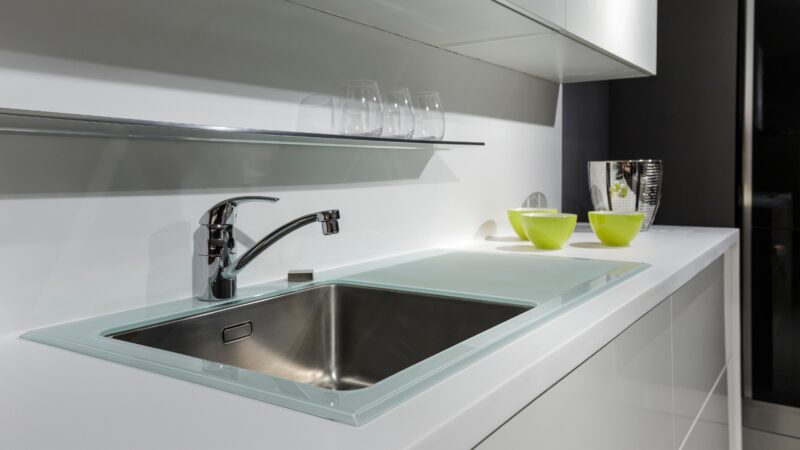
Ants can enter your kitchen through various cracks (for example, in floors or windows). The reasons why these insects love to be in your kitchen are water and food.
Ants love moisture and they naturally gravitate to the areas that have water (in this case, your sink or dishwasher). Moreover, if your sink has wooden components, the insects might build their nests in them (carpenter ants). Why leave this territory, if there is plenty of water and food there?
Related: What Attracts Ants? Information and Facts
Is It Dangerous to Have Ants Around the Kitchen Sink?
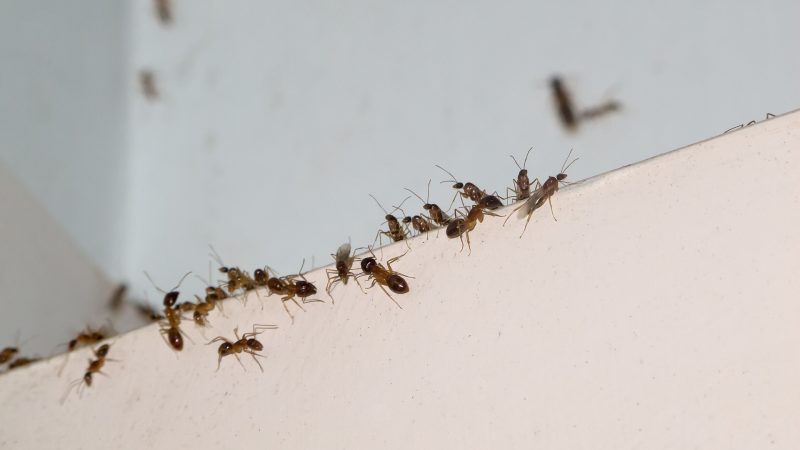
The last thing that you want is to discover a great big ant colony right next to your food. That it’s not just disgusting but having ants around the kitchen sink (and in any other place) can be quite dangerous as they have the potential to be vectors of foodborne pathogens.
First of all, all ants have the capability to bite while some can also sting. Some bites and stings might be painful, while others may cause an allergic reaction. Secondly, insects can damage your house. For example, some types of ants tunnel through wood.
Last but not least, ants can attract other pests to your house as they are a viable food source for some other insects. Ants can attract bats and spiders, for example.
Common Types of Ants in Kitchen Sink
Identifying the types of ants that are present in your kitchen can be helpful in selecting the appropriate ant killer and predicting their behavior. Different types of ants may have different nesting habits, food preferences, and responses to different types of ant killers.
Related: How Many Types of Ants Are There: Ant Identification Chart
Small Ants Around the Kitchen Sink
These little insects are usually around 1.5 mm (0.059 inches) in length (the queen can reach 4 mm or 0.157 inches). They are black or dark brown and usually nest around woodwork. They move indoors if they need moisture or in case you have been storing your food improperly.
Black Ants in Kitchen Sink
Black garden ant or the common black ant that is usually 3-5 mm or 0.118-0.19 inches long (size for the workers). However, these ants can increase in size over a few generations. These insects are glossy black and like to build their nests close to rotten wood. Black ants love sweet food and they lay a scent trail from their nest to the food, so that the others can follow it (pheromone trails).
Flying Ants in Kitchen Sink
Flying ants are not different “species” of ants. These are the ants that are already sexually mature, the “reproductives” of the colony that fly around trying to find the perfect place to start a new colony. Of course, flying ants prefer decaying wood and various cracks and if the place has enough moisture with some food sources, then they consider that as a great spot to start a new colony.
Tiny Red Ants in Kitchen Sink
Little fire ants are sometimes called “electric ants. They are around 1.5 mm (1/16”) long and have a golden brown or ginger body. Tiny red ants have a relatively painful sting. This is an invasive ant species that is usually present in agricultural fields. If you notice them around your sink, try to get rid of them as soon as possible.
How to Get Rid of Tiny Ants Around Kitchen Sink?
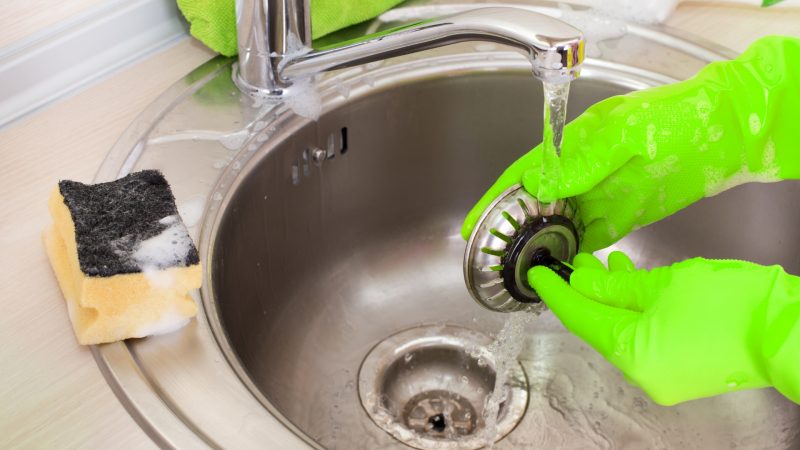
Ant management can be quite difficult for some people. Unfortunately, in a lot of cases, ants don’t just chill in your kitchen sink. They are usually located in the drain and crawl around the pipes in search of food and water. Getting rid of ants in places that you can’t really see can be really tricky.
Using a chemical ant killer in the kitchen sink drain is a bad idea. The chemicals are extremely hard to filter out and they might end up polluting your water and that’s dangerous to your health. Experts recommend using natural remedies to get rid of the ants inside the kitchen sink drain.
However, if you find that neither of the natural methods helps, you can consult a professional and pick the right type of ant killer. The best course of action would be to call professional ant exterminators, they will resolve your problem without any difficulties.
Simply remember to never use natural and chemical solutions simultaneously as the consequences can be unpredictable. We are going to be discussing home remedies in the later sections of the article.
Best Products for Ants in the Kitchen Sink
Of course, you can always use an ant killer spray. Some of them don’t have a chemical odor, so you might find them suitable for such an area as the kitchen. However, do remember that most sprays kill the ants only on contact. You will be able to get rid of the ants that you have spotted running around, but the sprays will not destroy the entire colony.
Using ant baits might be a better decision if your kitchen is infested. TERRO Prefilled Liquid Ant Killer II Baits, for example, is one of the most effective solutions that has been around for years. The bait consists of a sweetened liquid with the active ingredient borax.
- Convenient, ready-to-use bait stations with fast-acting formula
- Liquid ant killer bait station kills all common household ants
- No drips, spills or mess; for indoor and outdoor use. Place baits...
- Patented design eliminates handling of chemicals and prevents...
- Contains borax
Ants are attracted to the sweet solution. Moreover, it is easier for insects to consume liquid baits. The ants then take the bait back to the colony, feed the poison to the others, and kill the whole nest.
In case you want to tackle the cracks in your kitchen, use Syngenta – TRTD11568 – Optigard Ant Bait Gel Box. The thing comes in a syringe, so you can easily apply it right into the cracks.
- OPTIMAL CONTROL: Optigard Ant Gel Bait from Syngenta is a...
- EASY APPLICATION: This stainless, odorless ant bait is known for...
- TARGETS ALL MAJOR SPECIES: The sugar-based gel matrix of Optigard...
- EFFICIENT ANT CONTROL: Other baits can be too runny, which...
- COMPACT PACKAGING: Optigard Ant Gel Bait is packaged in...
The way the gel works is pretty similar to the bait. The insects will take the substance back to their house and poison the colony. This one is just easier to apply.
Home Remedy for Ants in Kitchen Sink
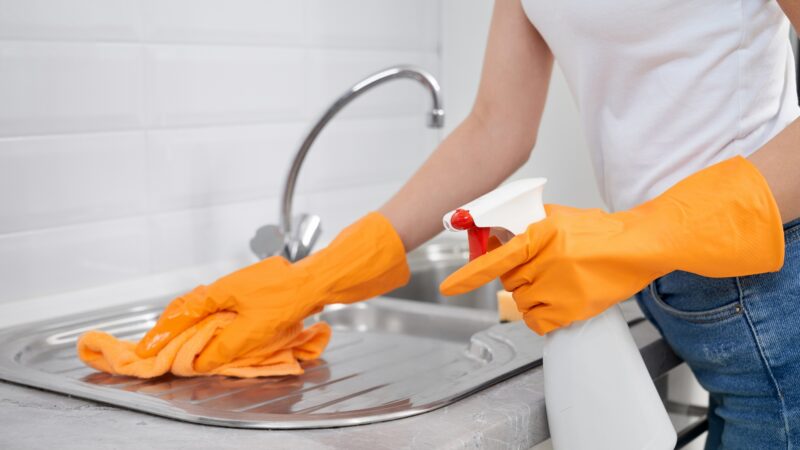
It is better to keep any chemicals away from your kitchen. And if you can avoid using poisonous substances, it is better to do that. The great news is that there are plenty of home remedies and natural solutions that can help you get rid of ants around the kitchen sink. The following are just some of them:
Ants Coming From the Kitchen Drain
The chances are high that there will be ants coming from your kitchen drain. If that’s the case, make sure to pour half a cup of baking soda down the drain. Add half a cup of white vinegar and leave it like that for at least 10 minutes.
The solution will start to bubble and will help you to loosen the grease residue that the ants are attracted to in the sink. After that, take some boiling water and slowly pour it down the drain. Hot water will kill the ants and remove any leftovers.
Ants in the Kitchen Sink
If you want to get rid of the ants that are located in your kitchen sink (not inside the drain), then mix 1 part dish soap with 3 parts water in a spray bottle. Shake up the mixture and spray it all over the sink. The soap will kill the ants and help ensure that the sink is nice and clean. Cover the entire area so that the ants can’t escape.
Cinnamon is possibly the most pleasant home remedy. For some reason, ants hate its smell. So you can use cinnamon to sprinkle it directly onto the ants or simply put some on the insects’ pheromone trails.
Chalk and baby powder can also help you to keep ants away from your kitchen sink. You can sprinkle some baby powder or draw a line with chalk around the area that is infested with ants. Ants will avoid stepping on these products.
Related: How to Get Rid of Ants | Safe and Effective Methods
Preventing Ants From Attacking Your Kitchen Sink
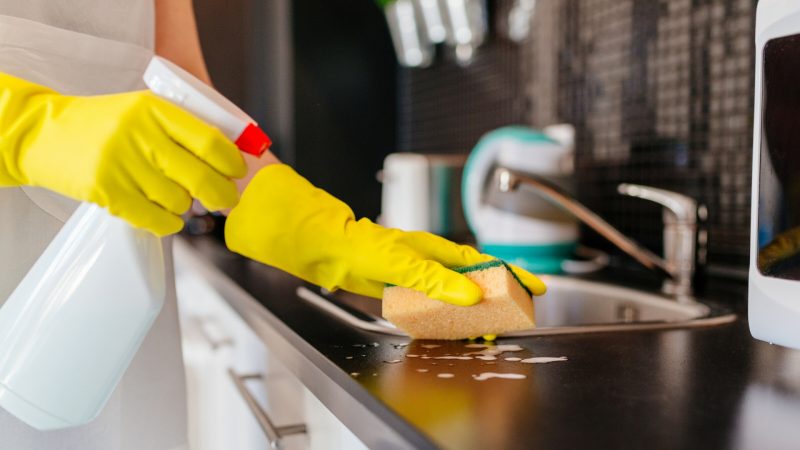
Of course, it is always easier to prevent an ant infestation than to treat it. After you have used any of the pest control methods mentioned above, make sure to take your time and seal any cracks in your kitchen that the ants might use in the future as an entry point.
Another important thing that will help you keep insects away from your kitchen is discipline. You will have to learn to store your food properly (use storage boxes that can be sealed tightly). Remove all the food from the kitchen right after the meal (even pet food). Clean any crumbs and spills straight away and take the trash out as often as you can.
You should also start doing the dishes after every meal. Moreover, the sink itself should never be left wet. Always use a dry towel to wipe the whole thing. To go the extra mile, you can trim any tree branches that are located too close to your house.
Related: Ants in Kitchen: How to Get Rid of Ants in the Kitchen
List of Sources
Potiwat R., Sitcharungsi R., Ant allergens and hypersensitivity reactions in response to ant stings, Faculty of Tropical Medicine, Mahidol University, Bangkok, Thailand
Potter M., Carpenter Ants, University of Kentucky College of Agriculture
Simothy L., Mahomoodally F., & Neetoo H. (2018), A study on the potential of ants to act as vectors of foodborne pathogens, Faculty of Agriculture, University of Mauritius
Ant Management, Connecticut Department of Energy and Environmental Protection
- How to Get Rid of Copperheads | Practical Guide - August 27, 2023
- How to Get Rid of Corn Snakes | What Makes Them Aggressive? - August 27, 2023
- How to Get Rid of Alligators | Safety Measures and Removal Methods - July 16, 2023


